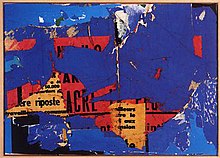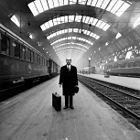Nouveau réalisme


Nouveau réalisme (French for "new realism") is an artistic movement founded in 1960 by the art critic
Contemporary with American
History
1940s and 1950s
The painter Jean Milhau coined the term “new realism” in the journal Arts de France, which was close to the French Communist Party, and defined this young movement in 1948: “A current is emerging which, without denying the achievements of modern culture and technology, denies the primacy of formal research, advocates a return to objective reality and to the subject, and emphasizes the social content of all reality". André Fougeron really launched the movement with Les Parisiennes au Marché, exhibited at the Salon d'Automne in 1948.[4] Painters like Boris Taslitzky, Jean Milhau, Jean Vénitien and Mireille Miailhe were also at its origin in France while Renato Guttuso, the "Italian Fougeron", was considered to be "at the origin of the new Italian realism", with his works on Sicilian peasants such as The Occupation of Waste Land in Sicily (1949) and Gabriele Mucchi with his painting La Terre representing a barefoot peasant holding earth in his hands, also reproduced in the magazine Arts de France as a painting representing the movement.[5] The new realism movement of the 50s eventually fell out of favour with the PCF and most artists associated with it soon changed their styles accordingly.[6]
1960s
The term new realism was again used in May 1960 by Pierre Restany, to describe the works of Omiros, Arman, François Dufrêne, Raymond Hains, Yves Klein, Jean Tinguely and Jacques Villeglé as they exhibited their work in Milan. He had discussed this term before with Yves Klein (who died prematurely in 1962), who preferred the expression "today's realism" (réalisme d'aujourd'hui) and criticized the term "New". After the first "Manifesto of New Realism", a second manifesto, titled "40° above Dada" (40° au-dessus de Dada) was written between 17 May and 10 June 1961.
The first exposition of the nouveaux réalistes took place in November 1960 at the Paris "Festival d'avant-garde". This exposition was followed by others: in May 1961 at the Gallery J. in Paris; Premier Festival du Nouveau Réalisme in
Ideas and techniques
The members of the nouveaux réalistes group tended to see the world as an image from which they could take parts and incorporate them into their works—as they sought to bring life and art closer together. They declared that they had come together on the basis of a new and real awareness of their "collective singularity", meaning that they were together in spite of, or perhaps because of, their differences. But for all the diversity of their plastic language, they perceived a common basis for their work; this being a method of direct appropriation of reality, equivalent, in the terms used by Pierre Restany, to a "poetic recycling of urban, industrial and advertising reality".[7] Artists of Nouveau Réalisme sought out to strip art of previously thought standards that art had to mean something, they could take any object beyond its preconceived notions and present it as itself, and thought it could still be considered art. Many of them also sought to break down the glamorization of artists producing their craft in private, and due to this, often art pieces were produced in public.[8]
Thus the nouveaux réalistes advocated a return to "reality" in opposition to the lyricism of
Nouveau réalistes made extensive use of
The new realists in architecture
"The new realists" is also a term applied to a group of Australian architects determined to create a "New Realism" in architecture, based on the understanding of past developments in the discipline of architecture and modern day explorations of new technologies in the fields of design and building technology.[citation needed]
The new realists
-
Arman, Foto: Lothar Wolleh
-
Villeglé, Foto: Lothar Wolleh
-
Niki de Saint Phalle, Foto:Lothar Wolleh
-
Jean Tinguely, Foto Lothar Wolleh
Bibliography
- Jürgen Becker, Wolf Vostell, Happenings, Fluxus, Pop Art, Nouveau Réalisme. Eine Dokumentation. Rowohlt Verlag, Reinbek 1965.
- ISBN 9782841050376[9]
- Nouveau Réalisme. Museum Moderner Kunst Stiftung Ludwig Wien, Verlag für moderne Kunst Nürnberg, 2005. ISBN 3-938821-08-6.
- Ulrich Krempel, Nouveau Réalisme. Revolution des Alltäglichen. ISBN 978-3-7757-2058-8.
- Jill Carrick, Nouveau Réalisme, 1960s France, and the Neo-avant-garde: Topographies of Chance and Return, Ashgate Press, 2010. [1]
- New Realisms, 1957–1962: Object Strategies Between Readymade and Spectacle, Museo Nacional Centro de Arte Reina Sofía, Madrid, 2010.
- Pierre Restany, Manifeste des Nouveaux Réalistes, Editions Dilecta, Paris, 2007.
- Poesie der Großstadt. Die Affichisten. Bernard Blistène, Fritz Emslander, Esther Schlicht, Didier Semin, Dominique Stella. Snoeck, Köln 2014, ISBN 978-3-9523990-8-8
- Nitas Natalie
References
- ISBN 3-8228-5907-9
- ^ ISBN 3-8228-2942-0[Nouveau Réalisme nouvelles approches perceptives du réel]
- ^ Rosemary M. O'Neill, Art and Visual Culture on the French Riviera, 1956–1971: The Ecole de Nice, Ashgate, 2012, p. 93.
- ^ "LA PEINTURE MILITANTE d'André Fougeron". Le Monde.fr (in French). 22 January 1951. Retrieved 11 February 2024.
- ISSN 1770-9571.
- ISSN 1262-2966.
- ^ 60/90. Trente ans de Nouveau Réalisme, La Différence, 1990, p. 76
- ^ "Nouveau Réalisme Movement Overview". The Art Story. Retrieved 21 March 2019.
- ISBN 978-2-84105-037-6.
External links
- "New Realism", article from the Centre Pompidou
- New Realism website, listing each of the artists




